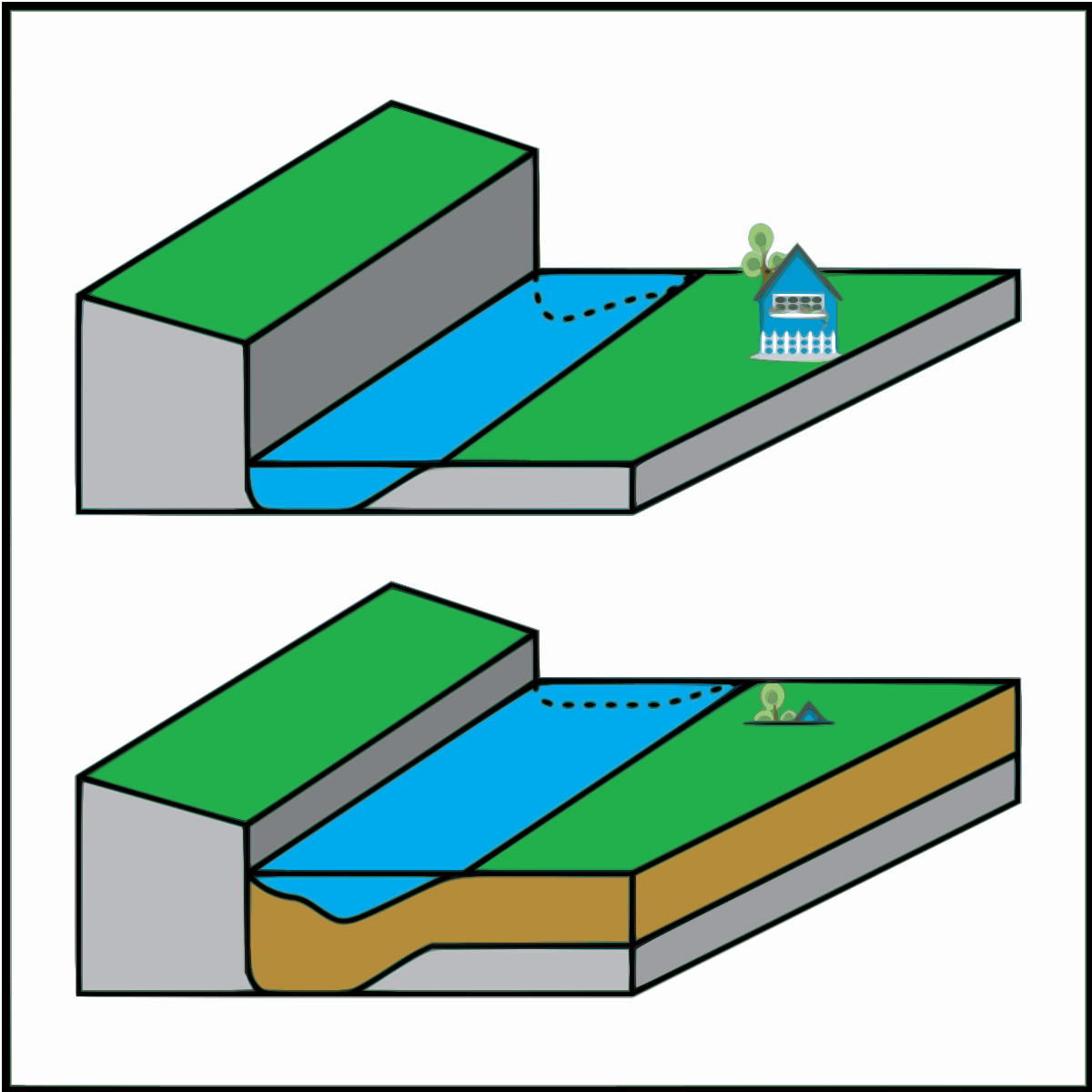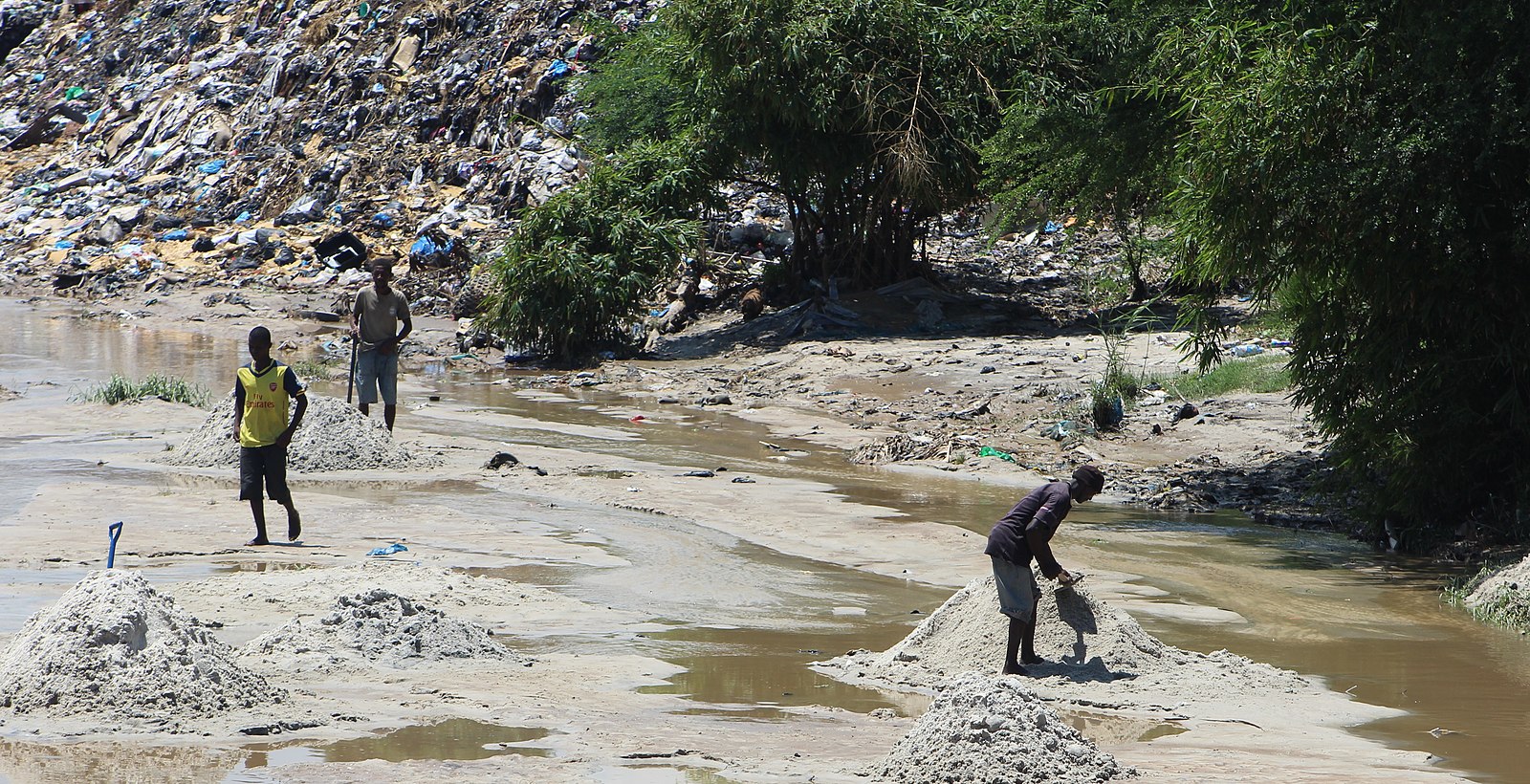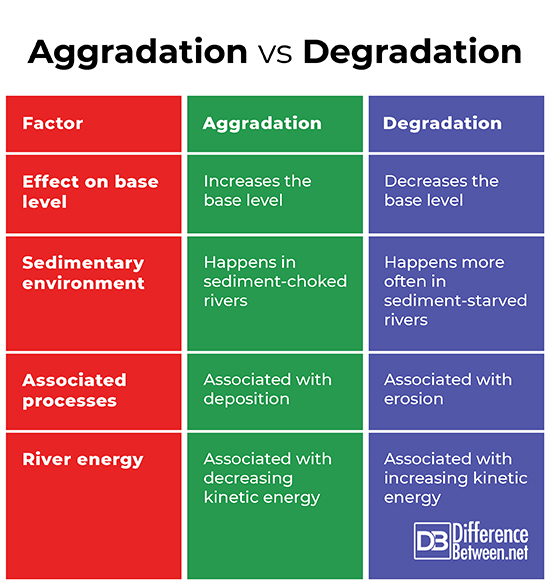Difference Between Aggradation and Degradation

What is Aggradation?
In geology, Aggradation is the process by which sediment is built up over time in a river or similar environment.
Rivers affect the landscape through a combination of erosion and deposition. As rivers run out of kinetic energy, they will begin to deposit sediment because they do not have enough energy to keep these sediments entrained. When sediments are deposited in a river, they raise the base level of the river. The base level is defined as the point below which the water in a river cannot cut into the riverbed and deepen it. During aggradation, sediment accumulates, gradually raising the riverbed. Aggradation probably most often occurs in rivers that are relatively sediment-choked so that they are near the limit of how much sediment they can entrain before depositing material due to a gradual loss in kinetic energy.
One environment in which aggradation is common is a braided stream or river. Braided rivers are rivers that have high levels of sediment entrained within them. Because of the excess sediment, it does not take long for these rivers to deposit large amounts of material as the river velocity decreases. Sediment becomes deposited as bars which divide the river into smaller channels, creating a braided appearance, hence the name.
Braided river systems are often found adjacent to glacial environments where rivers are fed by glacial melt water. Glaciers are known to move and accumulate large amounts of material. As glaciers start to melt, the melt water tends to be rich in debris, leading to a formation environment that favors braided river systems.
Aggradation is also impacted by the ecology surrounding a river system. For example, riverine and aquatic plants can take root in a river, creating an area resistant to erosion where other sediment can build up, creating a bar or platform.
Earth is not the only planet with aggradation since it is not the only planet with flowing liquids on its surface. Mars likely had aggradation in its ancient rivers. It is possible that the methane rivers of Titan also exhibit some form of aggradation.

What is Degradation?
In geology, degradation refers to the lowering of a riverbed, due the removal of sediment. Degradation happens when a river has an increase in kinetic energy so that entrained sediment is not able to settle out onto the bottom of the river. Degradation involves erosive forces where sedimentary particles are scraped or dragged along the riverbed and the edges of the river. As this occurs, emplaced sedimentary particles will be shorn off the riverbed, causing the water current to cut into the riverbed and deepen the river over time. When this happens, it results in degradation since the point below which the river cannot cut further into the underlying bedrock or sediment, the base level, decreases. Degradation is common in rivers with low sediment loads. Rivers tend towards equilibrium where they are neither eroding their riverbeds or accumulating sediment. This equilibrium level can be referred to as the grading of a river.
Often rivers and their tributaries will have the same grading so that there is no significant difference in base level equilibrium between a tributary and the stream or river to which it contributes. Where differences in grading do exist, a waterfall will result. These differences in grading are caused by processes that alter the gravitational potential levels of the land surface, such as glaciation. A difference in grading could also be caused by a particularly resistant rock layer.
The cause of degradation is usually related to changes in a river’s kinetic energy. This can be caused by an increase in glacial melt water, for example. In the longer term, it could also be caused by the steepening of a river due to tectonic uplift. In addition to natural forces that change the kinetic energy of a river, human activity can also impact degradation in a river. Dams, for example, can significantly affect the level of degradation. Humans are quickly beginning to outrank natural processes, such as uplift and erosion, as the main contributors to geomorphological change.
Similarities between aggradation and degradation
Aggradation and degradation both involve changes in the base level of a river. They are also both impacted by the amount of sediment in a river and the kinetic energy of a river.
Differences between aggradation and degradation
Although there are similarities between aggradation and degradation, there are also important differences. These differences include the following.
- Aggradation refers to an increase in the base level of a river, whereas degradation refers to a decrease in the base level.
- Aggradation is more likely to happen in sediment-choked rivers, whereas degradation is more likely to happen in sediment-starved rivers.
- Aggradation is associated with the deposition of sediment, whereas degradation is associated with the erosion of sediment.
- Aggradation happens as a river is running out of kinetic energy, whereas degradation happens as a river picks up more kinetic energy.
Aggradation vs. degradation

Summary
Aggradation involves the buildup of sediment in a river over time as material is deposited by a river that is decreasing in kinetic energy. This increases the base level of a river. Degradation involves the lowering of the base level of a river due to sediment being eroded off the riverbed. Degradation happens as the kinetic energy of a river increases. Degradation and aggradation are similar in that they are both controlled by the sediment entrained in a river and the kinetic energy of a river. They also differ in important ways. Aggradation increases the based level, happens in sediment-chocked rivers, is associated with deposition, and is associated with decreasing kinetic energy in a river. Degradation decreases the base level of a river, happens in sediment-starved rivers, is associated with erosion, and is associated with an increase in the kinetic energy of a river.
- Difference Between Environmental Performance Index and Development - November 24, 2023
- Difference Between Environmental Intervention and Development - November 8, 2023
- Difference Between Eco Efficiency and Eco Effectiveness - September 18, 2023
Search DifferenceBetween.net :
Leave a Response
References :
[0]“Aggradation.” The Physical Environment, n.d., https://web.archive.org/web/20051216143857/http://www.uwsp.edu/geo/faculty/ritter/glossary/a_d/aggradation.html.
[1]Ahmed, Joshua, et al. "Aggradational channels on Mars." EGU General Assembly Conference Abstracts. 2020. https://meetingorganizer.copernicus.org/EGU2020/EGU2020-19118.html.
[2]“Braided streams.” The Physical Environment, n.d., https://web.archive.org/web/20051216151703/http://www.uwsp.edu/geo/faculty/ritter/glossary/a_d/braided_streams.html.
[3]“Braided Stream Channels.” Climate Policy Watcher, 5 Dec. 2020, https://www.climate-policy-watcher.org/plate-tectonics/braided-stream-channels.html.
[4]Britannica, The Editors of Encyclopaedia. "Erosion". Encyclopedia Britannica, 22 May. 2020, https://www.britannica.com/science/erosion-geology. Accessed 23 February 2021.
[5]Faulk, S. P., et al. "Regional patterns of extreme precipitation on Titan consistent with observed alluvial fan distribution." Nature Geoscience 10.11 (2017): 827-831. https://www.nature.com/articles/ngeo3043?foxtrotcallback=true.
[6]“Glaciers and Glacial Landforms.” National Park Service, n.d., https://www.nps.gov/subjects/geology/glacial-landforms.htm.
[7]Gruver, J. B. “Prediction, Prevention and Remediation of Soil Degradation by Water Erosion.” Nature Education Knowledge, 2013, https://www.nature.com/scitable/knowledge/library/prediction-prevention-and-remediation-of-soil-degradation-113130829/. Accessed 20 Feb. 2021.
[8]Leopold, Luna B., and William B. Bull. "Base level, aggradation, and grade." Proceedings of the American Philosophical Society 123.3 (1979): 168-202. https://www.jstor.org/stable/pdf/986220.pdf.
[9]Mugade, Usha R., and Jagdish B. Sapkale. "Influence of Aggradation and Degradation on River Channels: A Review." Int. J. of Engineering and Technical Research 3.6 (2015): 209-212.
[10]“Proglacial.” Illinois State Geological Survey, n.d., https://isgs.illinois.edu/outreach/geology-resources/proglacial.
[11]Roussel, Erwan, et al. "Incision and aggradation in proglacial rivers: Post‐Little Ice Age long‐profile adjustments of Southern Iceland outwash plains." Land Degradation & Development 29.10 (2018): 3753-3771. https://onlinelibrary.wiley.com/doi/full/10.1002/ldr.3127.
[12]“What is Degradation?” Mid-America Regional Council—Environment, n.d., https://www.marc.org/Environment/Water-Resources/Missouri-Riverbed-Degradation/What-Is-Degradation.
[13]Image credit: https://commons.wikimedia.org/wiki/File:Aggradation.svg
[14]Image credit: https://commons.wikimedia.org/wiki/File:DEGRADATION_FOR_DEVELOPMENT.jpg
